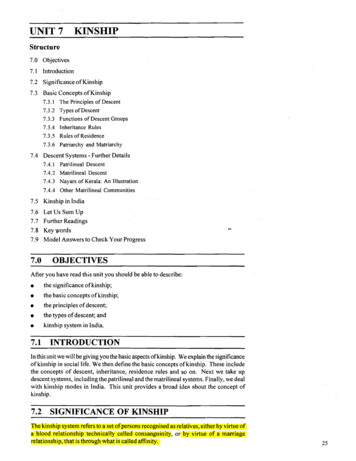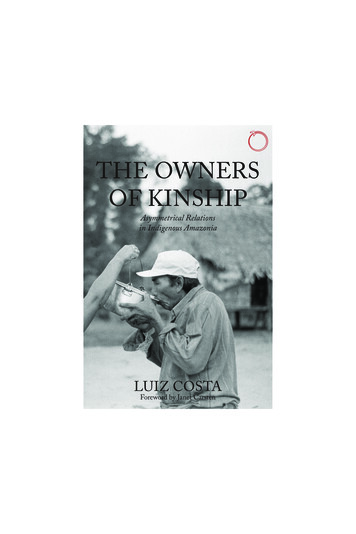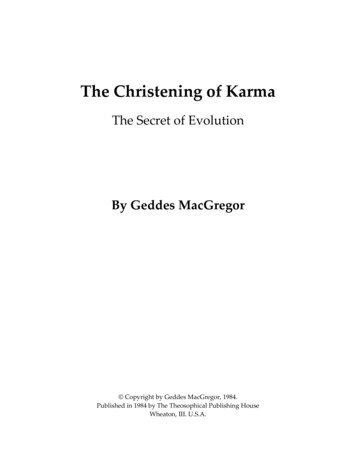
Transcription
UNIT 7 KINSHIPStructure7.0 Objectives7.1 Introduction7.2 Significance of Kinship7.3 Basic Concepts of Kinship7.3.1 The Principles of Descent7.3.2 Types of Descent7.3.3 Functions of Descent Groups7.3.4 Inheritance Rules7.3.5 Rules of Residence7.3.6 Patriarchy and Matriarchy7.4 Descent Systems - Further Details7.4.1 Patrilineal Descent7.4.2 Matrilineal Descent7.4.3 Nayars of Kerala: An Illustration7.4.4 Other Matrilineal Communities7.5 Kinship in India7.67.77.87.97.0Let Us Sum UpFurther ReadingsKeywordsModel Answers to Check Your Progress'OBJECTIVESAfter you ha.ve read this unit you should be able to describe:'the significance of kinship;the basic concepts of kinship;the principles of descent;the types of descent; andkinship system in India.7.1 INTRODUCTIONIn this unit we will be giving you the basic aspects of kinship. We explain the significanceof kinship in social life. We then define the basic concepts of kinship. These includethe concepts of descent, inheritance, residence rules and sp on. Next we take updescent systems, including the patrilineal and the matrilineal systems. Finally, we dealwith kinship modes in India. This unit provides a broad idea about the concept ofkinship.7.2 SIGNIFICANCE OF KINSHIPThe kinship system refers to a set of persons recognised as relatives, either, by virtue ofa blood relationship technically called consanguinity, or by virtue of a marriagerelationship, that is through what is called affinity.
Groups and InstitutionsMost of us tend to regard the kinship system into which we are born and in which weare reared as natural. It will seem natural and right to us that certain close relativesshould be tabooed as marriage and sexual partners, and we feel quite certain thatdisastrousconsequences would follow any infringement of the taboos. We inay similarlythink it natural that certain classes of persons he preferred as marriage partners, or wemay on the contrary think it very unnatural that a114 persons be so designated.We all have very strong ideas, too, about what is the correct and proper behaviour ofdifferent kin towards each other-deference, respect, familiarity, avoidance, kindliness,protectiveness, and so on, as the case may be. All such aspects of kinsliip relationstend to be taken for granted unless, or until, one is confronted with the kinship practicesof other peoples. Initially, different practices may appear as disgusting or inhuman,exotic or fantastic, strange or primitive, etc. Earlier anthropologists spent a great dealof labour on trying to work out tlie various stages through which they believed kinshipsystems had progressed in the course of human history. However strange other peoples'kinship practices may at first appear to be, a closer look will usually show them to befi nctional.They are useful for the maintenance of the society as a whole, contributingto its continuity over time and containing the conflicts that might potentially disrupt it.4This is not to say that all practices are for the best for all members of the society andfor all time. One certainly need notjustify customs like sati, female infanticide, childmarriage, amniocentesis or killing of the female foetus etc. One would here try toundersta idhow these practices are (or were) consistent with the principles and valuesat work in the wider society.7.3 BASIC CONCEPTS OF KINSHIPWe have already made tlie general point that kinship relations are the outcome of theculti ralinterpretation of relations given in nature, and discussed some of the differentways in which sociologists have looked at the kinship system. In doing so, we haveindirectly introduced some of the basic terms and concepts in kinship studies, whichwe will now set out more systematically. You certainly do not need to memorise thisrather overwhelming set oftech iicalterms, but you should try to understand the basicprinciples and distinctions that these key terms seek to convey.7.3.1 The Principles of DescentDescent is the principle whereby a child is socially affiliated with the group of his orher parents. In some societies the child is regarded as a descendant equally of both thefather and the mother, except that titles and surnames are usually passed down alongthe 111aleline. Such a system is termed Bilateral or Cognatic. The individual belongssimultaneously to several descent groups - those of the two parents, the fourgrandparents, the eight great-grandparents, and so on. This link is limited only byliiemory or by some conventionally determined cut-off point at, say, four or five degreesremoval. In small intermarrying communities, membership will probably overlap, andin case of dispute or feud, the individual might find his or her loyalties divided. Thereare some cognatic systems where the individual has the right by descent to membershipof several cog iaticallyrecruited groups, but this right is actualised only if the personis able to reside in a particular group's territory. Modern nationality iaws often makethis type of requirement.7.3.2 Types of DescentIn other societies, by contrast and your own is most probably one of them-descent isreckoned UNILINEALLY, that is, in one line only. The child is affiliated either wit11the group of the father, that is, PATRILINEAL DESCENT, or with the group of themother, that is, MATRILINEAL DESCENT. Theories ofthe physiology of procreation1
Kinshipand conception often correlate with these different modes of reckoning descent. In theformer, the father is often given the primary role in procreation while the mother isregarded as merely the carrier ofthe child; in systems of the latter type the father's rolemay not be acknowledged at all.Additionally, in some societies one finds that the child is affiliated to the group ofeither parent, depending on choice, or to one parent for some purposes (for instance,inheritance of property) and to the other parent for other purposes (for instance, theinheritance of ritual or ceremonial roles). This is called DOUBLE UNILINEALDESCENT.The principle ofunilineal descent provides the individual an unambiguous identificationwith a bounded social group that exists before he or she is born and that has continuityafter he or she dies. Members of a descent group have a sense of shared identity, oftenreferring to each other as 'brother ' and 'sister' even when no genealogical relationshipcan be traced. Descent groups are also very often, (though not inevitably), characterisedby exogamy. That is, marriage must be with persons outside this group. For instance,traditional Chinese society was divided among approximately a hundred 'surname'groups-you could perhaps call them CLANS-within which marriage was disallowed,and these groups further divided into LINEAGES, whose members claimed to be ableto trace their descent, perhaps for several hundred year, form a founding ancestor, andthen into further localised SUBLINEAGES and so on down to the individual co-residentfamilies. Soinetimes a whole village might be settled by members of a single lineage.The gotras of Indian caste society are also exogamous descent groups, segmented inrather the same way.1 Activity1Interview or discuss with some members of your family and prepare a chartindicating five generations of your family on your fathers' side or mothers' sidewhichever is relevant to you. Write a note of one page on "The kinship structure ofMy Family". Discuss your note with other students and Academic Counsellor atyour study centre.I7.3.3 Functions of Descent GroupsLApart froin the function of exogamy, unilineal descent groups tend to be 'corporate' inseveral other senses. Their members may often come together for ritual and ceremonialfunctions, for instance, for collective worship of lineage gods, totems or ancestors.The descent group will have a built-in authority structure, with power nor nallyexercisedby senior males, and it may well own corporate property. An individual's economicrights and responsibilities will be defined by his or her position in the descent group.manysocietiesI 11unilineal descent groups are also jural units, internally deciding their own disputes,and externally acting as a unified group in the conduct of feud, etc. For this reason,lineage structure is often coterminous with the political structure in societies lacking acentralised state structure.Lineages cannot expand indefinitely in a single locality and often segment into smaller,more manageable and economically viable lineage segments. You can see the lines ofsegmentation of the ground, as it were. Consider the pattern of land ownership in anIndian village; or at the pattern of village or urban settlement; aparticular quarter ofthe village or town may be inhabited by the descendants of a single founding ancestor.Often, the large havelis divide among brothers or step-brothers, and these quarters arefurther divided amolig their descendants. In case a line dies out, the property would bereconsolidated.
Groups and InstitutionsGiven the range of social functions that descent groups may potentially perform, it islittle wonder that concern with the principles of unilineal descent has dominated thework of many students of comparative kinship. However, even these scholars realisethat unilineal descent is not the whole story. In ancient Rome, women after marriagesevered all contact with their natal group. In certain slave societies, the slave has no'family' of his or her own. In patrilineal systems, the mother's father, mother's sister,and especially the mother's brother, are important relationships which needfurther discussion. To take note of the importance of relationships, the scholarshave identified another principle. This has been termed the principle ofCOMPLEMENTARY FILIATION which explains the significant ritual and socialroles of the mother's brother(s) in the lives of their sister's children. It reminds us that,in most societies, an individual is a child of both parents, however descent is formallyreckoned.7.3.4 Inheritance RulesRules of inheritance tend to co-ordinate with the reckoning of descent in most societies,but not necessarily in a one-to-one manner. In fact, it is quite often the case that certaintypes of property pass from father to son, and other types form mother to daughter. Inmost parts of India, in the past, immovable property such as land and housing, wasinherited only by sons. In the absence of sons, except under rare circumstances, by thenearest male relatives on the father's side. One the other hand, movable property inthe form of cash and jewellery was given to the daughter at the time of her marriage,with a certain amouqt of jewellery also passing from the mother-in-law to thedaughter-in-law.'1In addition to property of various kinds, rights and obligations, esoteric knowledge,crafts and skills, etc., might be passed on in accordance with kinship roles, successionto office to chieftainship, kingship, etc.-and to other social roles and statuses, is alsovery often determined by kinship criteria. In such cases, the individual's status is saidto be 'ascribed', not 'achieved'. It is commonly asserted that ascriptive status ofmodern, industrial societies. There is a great deal of truth in this statement, but oneshould not underestimate the importance of kinship connections in modernsocieties too. Often one finds that in a family if father is a doctor or lawyer the son ordaughter is also likely to choose the same occupation. Most ofthe Indian women whohave been successful in the political domain are either daughters, sisters or wives ofpeople who have been active in politics. One such example is the Nehru family ofIndia.7.3.5 Rules of ResidenceRules of residence, meaning residence after marriage, are an important variable in akinship system, and substantially affect the quality of personal relations within the kinnetwork. Ifhusband and wife set up their own independent home after marriage, as isusually the case in modern western society, residence is said to be NEOLOCAL.Wherethe wife goes to live with the husband in his parents' home, residence is described asVIRILOCAL, PATRILOCAL, or PATRIVIFULOCAL, and where the husband movesto iive with the wife, it is termed MATRILOCAL or Rules of residence may or may not'harmonise' with the rules of descent. On the whole, patrilineal descent systems correlatewith either neolocal or patrivirilocal residence patterns. However, matrilinealdescent systems may be combined with all three types of residence. It is also Combinedwith what is called AVUNCULOCAL residence, that is, residence with the motller'sbrother.
KinshipILLUSTRATION : I different types of Residence(i) Neolocal (ii) Patrivirilocal (iii) LOCAL4MAN-fgjWOMAN MARRIAGEBMALE FEMALEIOFFSPRINGLegend:7.3.6 Patriarchy and MatriarchyA society is said to have a patriarchal structure when a number of factors coincide, i.e.when descent is reckoned patrilineally, when inheritance of major property is fromfather to sol;, when residence is patrilocal, and when authority is concentrated in thehands of senior males. There is, however, no society on earth, nor any society actuallyknown to have existed, whose features are the exact reverse of these. For even inmatrilineal,matrilocal systems, which are fairly rare, major property is usually controlledby males. And authority is normally exercised by males, though women may wellhave a higher status in the family and greater powers of decision-making than in thepatriarchal set up. Some anthropologists assert that in societies with very simpletechnology and minimal property, relations between the sexes are relatively egalitarian,whether descent is formally matrilineal, patrilineal or bilateral, but others insist thatwomen, and children, have played subordinate roles in all human societies.Forthis reason, the term 'matriarchy', though often found in the literature, is probablya misnomer, best avoided, and there is certainly no conclusive evidence to support theview that matriarchy was a universal early stage in the development of kinship systems.Check Your Progress 1Note:i)ii)1)Use space below for your answers.Compare your answers with those given at the end of this unit.What is the principle of descent? Explain in one line.
Groups and Institutions2)Explain the types of descent. Use about three lines for your answer.7.4DESCENT SYSTEMS-FURTHER DETAILSThe patrilineal descent systems of India have many of the features noted in similargroups elsewhere. A boy at birth becomes a member of his descent group, and acoparcener (partner) in a joint estate. A girl, by contrast, is only a residual member ofher natal group: at merriage she is incorporated into her husband's descent group andultimately (i.e. after her death) offered worship by their male descendants. Residence,as we have already noted, is usually partilocal.The descent group may participate in joint rituals such as the worship of certain deitiesand ancestor worship, and will observe mourning restrictions, in various degrees,following a death in the family. It may also own a certain amount of common property.Immovable property such as land and housing is inherited in the male line only (ofcourse, we are speaking here of the traditional system, before the several changessought to be brought about by post-independence legislation). Whereas daughters aregiven goods, cash and jewellery as 'dowry' at the time of marriage. The descent grouphas an in built authority structure based on generation and age. Senior members havethe authority to settle disputes within the kin group, and to represent the group\in itsdealing with outsiders.7.4.1 Patrilineal DescentTaken together, the above mentioned features approach the 'patriarchal' model of society.This has patrilineal descent, patrilocal residence, inheritance from father to son, andauthority in the hands of seniors as against juniors, and males as against females. Anumber of social practices testify to the fact that a woman's only legitimate roles arethose ofwife and mother. Spinsterhood and widowhood are inauspicious and unenviableconditions. A girl is regarded as merely a guest in her natal home and, initially at least,as a rather threatening outsider in her marital home. The poignancy of the transitionbetween these two locales and these two statuses is captured in folklore and folksongswith which you are probably familiar.The patrilineal systems of the south are not so markedly patriarchal as those of thenorth. Also a wplnan after marriage continues to have materially and psychologicallyimportant relations with members of her natal group. This is more so with her parentsand her brothers, and the residual right to maintenance in their estate in adversecircumstances. And in many other partilineal systems, the mother's brothers havesignificant ritual and social roles in the lives oftheir sister's children, and an especiallytender and affectionate relationship with them.Further modifying the starkly 'patriarchal' picture a number of social anthropologists,speaking comparatively, have also drawn attention to the fairly substantial propertythat devolves on a daughter at her marriage. Others, however, insist that this propertycannot be considered as a daughter's 'inheritance', comparable to that ofthe son, sincethe greater portion of it is neither owned nor controlled by the girl in her own right. Itis really a form of 'bridegroom price', that is, an enticement to the groom's family aspart of the settlement of the marriage contract. However, equal rights of inheritanceby both son and daughter in one's father's or mother's self made property is recognisedand same states have even introduced it in their legislation,
7.4.2 Matrilineal DescentMatrilineal descent systems, of which there are several well-known examples in southwestern and north-eastern India, have their own distinctive characteristics. Empiricallyyou never find matrilineal systems that are an exact inverse of the patrilineal-patriarchalmodel which we liave already described and which is fairly well approximated by thepatrilineal descent systems of north and south (but especially north) India. The reasonis quite simple: whatever tlie descent system, that is, matrilineal, patrilineal or indeedbilateral, authority is usually exercised by males, only in extremely simple societiesone comes across a fair degree of mutual inter-dependence between males and females.Also, tliougli rights, in property might be determined by the principles of matrilinealdescent (for instance, passing from mother to daughter or from mother's brother tosister's son rather than from father to son as in patrilineal societies), major property isusually controlled (if not actually owned) by males.For obvious reasons, residence arrangements are problematic in matrilineal societies.A man may not have authority over his own children, who belong to his wife's descentgroup and who may also reside after maturity with their mother's brother. Conversely,in cases wliere the husband customarily resides with his wife and children, he mayliave difficulty managing the property in which lie has an interest by virtue of descent,and in exercising authority over his sister's children. 111other words, there seems to besome sort of contradiction in matrilineal kinship systems, brought out in the dilemmaover residence, between a man's role as father and his role as mother's brother. Hisnatural love for his own children might easily come into conflict with his special juralresponsibilities towards his sister's children.7.4.3 Nayars of Kerala: An IllustrationAmong the matrilineal Nayars of Kerala, formerly, men resided in large and matrilineallyrecruited joint families, called taravad, along witli their sisters, sister's children andsister's daughter's children. They visited their wives in other taravads at night (this iswhy the system has been popularly called tlie 'visiting husband' system). Their ownchildren resided with their mother in their mother's taravad. In this system the bond6etween brother and sister was strongly emphasised, and the bond between husbandand wife correspondingly de-emphasised, this is more so because Nayar women couldlegitimately have a number of visiting husbands (polyandry), provided they were ofthe correct status (i.e. higher status Nayars or Namboodiri Brahmans). Also, Nayarmen could liave a number of wives (polygyny). In fact, the marital bond was so ninimisedamong the Nayars that anthropologists have debated endlessly whether Nayarsociety liad the institution of marriage at all! Anthropologists have also cited that theNayar system disproves tlie proposition that the elementary or nuclear family is a"universal" human institution. The details of these debates need not detain us here.Indeed, the unique institutions and customs described by the anthropologists no longerexist and have not existed for generations, but tlie Nayar case is a useful one forillustrating the types oftensions that seem to be coming into matrilineal systems. Theyliad aratlier unique way ofcoping with what anthropologists have called 'the matrilinealpuzzle'. Effectively they ensured the unity of the matrilineal at the expense of thesolidarity of the marital bond between husband and wife.7.4.4 Other Matrilineal CommunitiesThere are many other matrilineal communities in India whose kinship organisation israther different to that ofthe Nayars. For instance, the Khasis of Assam are matrilinealin descent, inheritante and succession, and practise matrilocal residence. The youngestdaughter is tlie heiress, and lives in her mother's house alone witli lier husband and lierchildren. The older daughter however may move out of the matrilineal household onmarriage and make new nuclear families; their husbands liave greater independentKinship
Groups and Institutionsauthority than does the husband of the youngest daughter still residing martrilocally.The Garo, also of Assam, have yet another arrangement. Marriage is matrilocal forthe husband ofthe daughter who becomes the head of the household and its manager.A rule of preferential cross-cousin marriage ensures that a man is succeeded in thisposition by his sister's son in an ongoing alliance relationship between the two linkedlineages.Earlier anthropologists, working within an evolutionary framework, had maintainedthat the matrilineal descent systems are the surviving traces of an earlier matriarchalor 'mother-right' stage in the development of human kinship organisation, and thatthese would automatically give way to patriarchal and then bilateral models. There isno conclusive evidence that this has happened or is currently happening. At least in theNayar case it appears that the decline of the Nayar taravad over the last century hasgiven rise to a wide variety of residential patterns in the area, and it has become exactlylike the patrilineal groups in their neighbourhood.Sociologists and anthropologists continue to find matrilineal descent groups of specialintere t, not only because of the ramifications of the 'matrilineal puzzle', referred toabove, but also because issues concerning the status of women or gender relationshave come very much to the fore in recent years. It may be, as we have stated, thatmales have authority and exercise control over property in both patrilineal and matrilinealsocieties, but most scholars working on matrilineal societies, and the members of thesesocieties themselves, feel that there is nonetheless a qualitative difference in the statusof women in matrilineal, as against patrilineal, societies.Activity 2Think about emergency situation in your own family, such as, economic crises,death, birth etc. Try to recall the people from whom your sought help and howthese people were linked with you. Write a report on "kinship in my Family1Community" and discuss it with other students at your study centre.Check Your Progress 2Note: i)ii)1)Use space below for your answers.Compare your answers with those given at the end of this unit.Write a brief note on the patriarchal model of society. Use about three lines foryour answer.2)Explain matrilineal descent. Use about two lines for your answer.7.5 KINSHIP IN INDIAFrom your general knowledge, what would you say are the distinctive features ofkinship in the north and south of India? Almost everyone, spontaneously, thinks ofthedifferent rules of marriage, and ofthe kinship practices that derive from these. We willnow briefly enumerate here the sort of contrasts that Iravati Karve, the famoussociologist, had described.
In the Southern Zone, you usually find a preference for marriage with certain categoriesof close kin, in particular with one or the other or both of the cross-cousins (but neverparallel cousins), or even with the elder sister's daughter. On the whole, the intermarrying groups are of comparable status. Though the actual marriage relationshipmight give rise to a temporary inferiority of wife-givers in relations to wife-takers.The marriage will probably involve groups which are geographically quite proximateeven from the same village-and the bride will already be familiar with her in-laws.You don't really expect a young bride to be badly treated by her mother-in-laws ifthatwoman is also her aunt or her maternal grandmother!In north India, by contrast, marriages are never between persons who are alreadyclosely related. A rule of village exogamy also ensures that brides are given to andtaken from other villages or towns, often at a considerable distance. The bride thereforecomes to her husband's family as a 'stranger'. She will always be suspected oftryingto alienate her husband's affections, and will usually be blamed for the break up ofthejoint family, should a partition subsequently take place. The distinction between'daughters' and 'brides' is very sharply emphasised in this system (think ofthe practiceof veiling), and the new bride's position is relatively vulnerable, unless and until shebecomes the mother of a son. In this region it is also often the case that marriages unitegroups whose social status is already unequal, the wife-givers being of inferior statusto the wife-takers (hypergamy), while the marriage transaction commonly (thoughagain not invariably) takes the form of a 'dowry' payment. However legally takingdowry or giving it, both have become illegal offences punishable by the state. But, inreality it continues to affect a large category of people in India. Even other religions,such as, Muslims, Christians and SCISTs are getting influenced by it. All in all, wehave in this combination of features the social-structural locale of also such practicesas levirate marriage, sati, female infanticide and, lately, 'bride-burning' or dowry deaths.Box 7.1In 1980 the government of India began to take notice of the issue of dowry asoppression against women and took legal action against it. In December 1983the Criminal Law (Second Amendment) Act was passed. Section 498-A wasadded to the Indian Penal Code. Under this Act cruelty to a wife was made acognisable non-bailable offence, punishable up to three years imprisonment,and a fine. Section 113-A ofthe Evidence Act was amended so that court coulddraw an inference of abetement to suicide (which most dowry deaths are claimedto be) under section 174 of the Criminal Procedure Code. (IGNOU:.2000, WEDProgramme, WED-01, pp. 34)*k.Other differences between the northern and southern systems noted by 1ra;ati Kame(and others) relate to the rules of descent, inheritance and marriage. In brief, thenorthern zone is universally patrilineal, though patrilineal systems are also found amongdifferent communities in the southern or dravidian zone, along with a variety of residencepatterns. We should add here that there are a number of important matrilineal groups(for instance the Khasis and the Garos) in north-eastern India (eastern zone) as well.Of course, the division of the kinship may develop into major culture areas zones cangive only a very crude idea ofthe salient variations in kinship practices throughout thesubcontinent. A more precise picture emerges when one considers the sub-regionalvarieties corresponding to the different regional languages and dialects. In analysingthese regional kinship systems, scholars pay attention not only to kinship terminologiesand to the way the people concerned speak about kinship relations and about the moralobligations that stem from them, but also to the data of ritual practices, gift exchangesfolklore and other forms of cultural communication.Kinship
Groups and Institutions7.6LET US SUM UPIn this unit we have provided information about kinship. We have shown quite clearlythat kinship is significant to society. Moreover we have clearly indicated that the basickinship concepts like descent, inheritance and residence are important in all societies.We also showed how patrilineal and matrilineal system are aspects of descent systems.Finally kinship in India was examined in this unit. This unit therefore provides adequateinformation about various aspects of kinship.7.7FURTHER READINGS1)Faber, Bernard (ed.), 1966. Kinship and Family Organisation, Johan Wileyand Sons: New York.2)Fox, Robin 1967, Kinship and Marriage. Penguin Books : New York.7.8KEYWORDSConsanguinity: The principle of recognising kinship by virtue of bloodrelationships.The principle of recognising relationship throughmarriages.Descent: The system of deriving relationships from an ancestor.Bilateral or Cognatic: The system of descent in which a child is recognisedas a descendant equally of both the father and themother.: The system of descent in which relationship with theancestor is recognised in one line only, i.e. either offather or of mother.Double unilinealThe system of descent in which the child is affiliafedto the group of either parent.Patrilineal: Implies that descent is t
7.3.1 The Principles of Descent 7.3.2 Types of Descent 7.3.3 Functions of Descent Groups . or by virtue of a marriage relationship, that is through what is called affinity. . have been successful in the p










